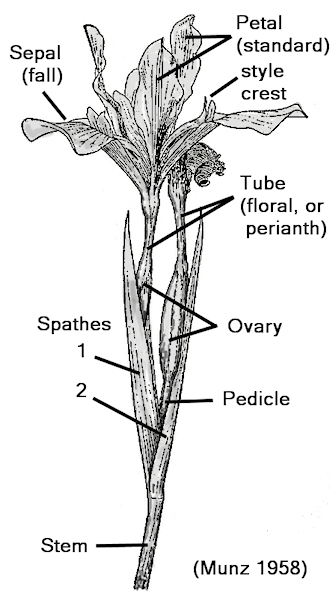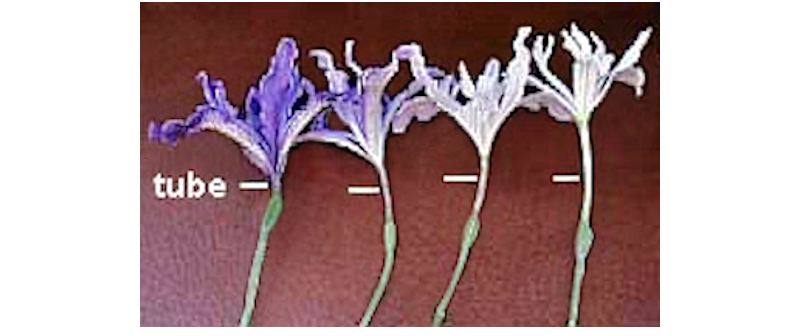Wild PCN iris - the three main groups:
Which Species Are You Looking At?
If you want to identify wild plants and animals, you've got to have good keys, descriptions, drawings, maps and reference photographs. A new, exceptionally helpful resource is the online galleries of naturalist-photographers like Ron Parsons, Mary Gerritsen, Eric Hunt and Tom Chism.

Keep in mind that every population has spent hundreds, or more likely thousands, of generations adapting to the conditions of its own local habitat. Its members can often be distinguished from close relatives (even those of the same species) living farther away. Note too that one individual may not be typical of the larger population.
Keys used to identify the twelve PCI species are all based on one put together by Lee Lenz in his report, "A Revision of the Pacific Coast Iris". Most species fall into one of two groups, according to a couple of easily seen features. The four species somewhat outside these groups can be identified by their own special characteristics.
Lenz evaluates each feature used to distinguish the different species. Knowing where a plant lives helps narrow the choices. Flower color is usually helpful, although most species have several color varieties, and occasionally one shows a full range - from white, cream and yellow to violet, lavender and deep purple.
Victor A. Cohen's "Guide to the Pacific Coast Irises" includes a series of very helpful drawings. They illustrate the outstanding characteristics of each species, and have been adapted to descriptions on the following pages. Two key features are the floral tube length and the open or closed position of the spathes.
1. Floral (perianth) tube length. Five long-tube species have floral tubes between the ovary and petals measuring between 1½ and 3½ inches or more in length. A second group of three species has short floral tubes measuring less than one inch long. Four unique species have intermediate length floral tubes and are identified by other features.
2. Spathe position. All PCIs have a pair of spathes or leaf-like structures (bracts) on the stalk just below the ovary that either enclose and protect the ovary (long-tube group), or separate outward away from the stem leaving the ovary exposed (short-tube group). The four unique species somewhat outside the two main groups have their own characteristic spathe arrangement.
THE THREE MAIN GROUPS:
A. Unique species: 1. Douglas iris (Iris douglasiana), 2. Siskiyou iris (I. bracteata), 3. Golden iris (I. innominata), 4. Thompson's iris (I. thompsonii).
B. Long-tube species: 5. Bowl-tube iris (I. macrosiphon), 6. Fernald's iris (I. fernaldii), 7. Purdy's iris (I. purdyi), 8. Yellow-leaf iris (I. chrysophylla), 9. Shasta iris (I. tenuissima).
C. Short-tube species: 10. Sierra iris (I. hartwegii), 11. Tough-leaf iris (I. tenax), 12. Munz's iris (I. munzii).
A BASIC IDENTIFICATION KEY
We provide here a SIMPLIFIED KEY to help get you started identifying wild Pacifica iris. Keys like this cannot be relied upon to identify natural or nursery-bred hybrid iris.
THE PROBLEM OF HYBRIDS
The main difficulty in identifying wild Pacific Coast iris is caused by their willingness to cross pollinate whenever their ranges overlap. The twelve species are easy to describe based on their unique features, but individual plants often prove difficult or impossible to assign to one of those species. If your iris comes from a place where the ranges of two or three different species overlap (or if it was bred in a nursery), it may actually be a hybrid – with the blended features of multiple parent species.

Lewis and Adele Lawyer illustrated the challenge of identifying hybrid Pacifica iris. They photographed four wild iris flowers, including a tough-leaf iris (short tube, on left) and a yellow-leaf iris (long tube, on right). The two in the center are tough-leaf / yellow-leaf hybrids, with intermediate length floral tubes.